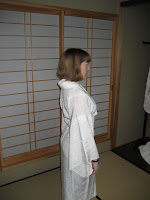Tabi are split-toed socks, which come to just above the malleolus (ankle bone). I put them on after my underwear, but before my underrobe and kimono, because once you start getting all the parts of a kimono on, it becomes difficult to bend at the waist and putting the socks on would be next to impossible.
Tabi have been worn in Japan since the sixteenth century, reaching their peak during the Edo period (1600-1868). They were developed to wear with sandals: the split between the compartment for the big toe and the remaining toes allow for the hanao (thong) of the sandal. According to
Shiatsu theory, wearing Tabi socks benefits the back, the spine, and the digestion due to the acupuncture meridians located between the toes.
Tabi were traditionally hand-made to customers specifications/measurement, but production became mechanized in 1885, when Tsujimoto Fukumatsu established a factory and instituted a "business by volume" policy (a new tactic in Japanese business a the time--for an article about pre-WWII distribution systems in Japan, go
here--it's quite interesting) by using altered German sewing machines. He managed to produce so many tabi that tabi went from something most people only wore in the winter to an everyday fashion item! Today, production is still mechanized, but
there are tabi "masters" who preserve the art of hand-sewn, custom tabi.Tabi are traditionally made from cotton and fasten with flat hook-and-eyes. Tabi should be tight-fitting and smooth, with white tabi worn by both men and women for formal occassions. Men in daily wear kimono will wear dark tabi and a recent trend has women wearing colored tabi with their daily kimono. Cotton tabi remain derigeur for dancers and martial artists, but most kimono folks wear a stretchy polyester tabi, since the are easier to wear and care for. It is my opinon though, that they are not as comfortable or as long-lasting as cotton tabi.
A lot of Japanese wear tabi just because they like them and/or find them more comfy or "healthier" for their feet. They wear spun/woven tabi (like our regular socks, but with a split toe) Spun/woven tabi come in a variety of cotton/wool/nylon and all kinds of fun designs. I buy many of mine from the 100 yen shop (like a dollar store). To put these on, you just make sure you have the correct sock for the foot (yes, they are left/right) and pull them on.
Shown in the picture below are some of my tabi. I have a whole sock drawer full of inexpensive pull-on ones for everyday wear. The crazier the pattern, the better! Tabi have pretty much replaced my western socks. You can see spotted nylon pull-on tabi and below those are very thick woolen tabi to wear instead of slippers (note the "grippy dots" on the bottom). Then I have colored pull-on stretch tabi, for wear with yukata or informal kimono and below those are white stretchy tabi which fasten closed with teeth, appriopriate for everyday wear, but also acceptable for formal occassions. Then you see the flower-print cotton tabi with fasteners and lastly, below them are the very traditional white cotton tabi.























